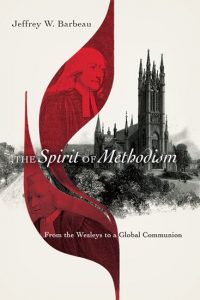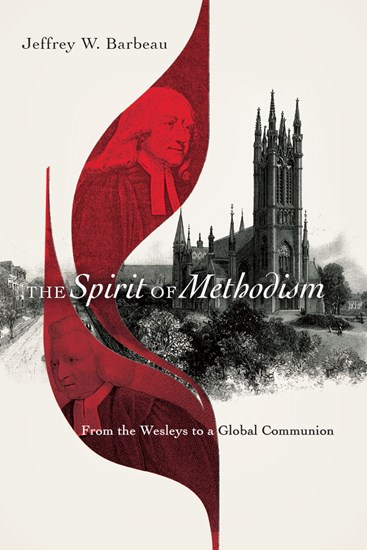Jeffrey W. Barbeau, The Spirit of Methodism: From the Wesleys to Global Communion. Downers Grove, IL: IVP Academic, 2019, pp. 224, $20, paperback.
Jeffrey W. Barbeau, professor of theology at Wheaton College, has written a history of Methodism at a moment of crisis within the United Methodist Church. As this review is being written, the specter of conflict threatens to divide that denomination. The debates over sexuality that drive this conflict have been going on for several decades, but seem to be coming to a head. Many United Methodists feel anything but united.
Barbeau writes with the hope that a coherent history of Methodism will help readers gain some perspective: “If the future of the movement seems uncertain to many American Methodists today,” he writes, “at least part of the problem is a persistent myopia” (p. 101). To address that myopia, Barbeau has produced a short, easily-read survey of the history of Methodism, or more accurately, “Methodisms.” The Spirit of Methodism rightfully covers not just Methodism in Great Britain and the United States, but in south Asia, east Asia, Africa, and Latin America. Barbeau also reminds readers that Methodism is not just the United Methodist Church, but also other Methodist, holiness, and Wesleyan denominations—such as the African Methodist Episcopal Zion Church and the Salvation Army. These different Methodisms point to the sheer breadth and diversity of the movements that sprang from John Wesley’s ministry.
Rather than original scholarship for academics, The Spirit of Methodism is a survey for interested laypeople and seminarians. Still, Barbeau has set for himself a tall order, bringing coherence to a movement containing millions of people over two and a half centuries, from numerous denominations, living in the major cultural regions around the globe. Barbeau is quite aware that generalizations have to be made, some eras and movements will be left out, and the day-to-day experiences of ordinary Methodists cannot be unpacked with any depth. To describe the core of historical Methodism in such a short account, Barbeau addresses both large-scale, structural developments as well as the personal, spiritual promptings in individual lives. The Spirit of Methodism highlights representative leaders from different eras and regions, as a way to illustrate particular spiritual and social dynamics of Methodism. Of course, the famous “founding” personalities are here, like John Wesley and Francis Asbury. But Barbeau also touches on personalities that appear less often in popular histories of Methodism, such as Phoebe Palmer and John Mott. More importantly, Barbeau brings to the forefront important Methodists from around the world that would only be known to specialists of particular branches of Methodist history, such as D. T. Niles in Sri Lanka, Thomas Birch Freeman in West Africa, and Willis Hoover in Chile. Many of these individuals get a concise summary in an inset box, as do key events, practices, and organizations, such as the stillness controversy, love feasts, and the World Council of Churches. Throughout the narrative, Barbeau regularly links new developments back to theological principles, sermons, or practices of John Wesley.
What holds these disparate bodies and individuals together? Barbeau argues that it is grace, “the active presence of the Spirit of Christ” (p. xiv). With this framework, The Spirit of Methodism moves perceptions of the historical core of Methodism away from opposing oversimplifications — either as a set of evangelical doctrines or progressive theological innovations. By arguing instead for a “Broad Church Methodism,” Barbeau seems to be speaking primarily to the opposing sides of the conflict within the United Methodist Church today, as well as insular oversimplifications that may operate within other Methodist and Wesleyan denominations.
If Methodism is framed within the American context, the cultural and theological power of these oversimplifications make it uncertain that many will embrace Barbeau’s approach of a Broad Church Methodism. There is more hope, however, if the scope is global. That is why the substantive inclusion of Methodists from Latin America, Africa, and Asia form such an important part of the story. The burning of fetishes in Korea or E. Stanley Jones’s Christian ashrams in India hint at complicated theological and cultural issues that most North American or British Methodists have yet to come to terms with. As a survey, The Spirit of Methodism cannot explore these issues with any depth and so it is possible many readers will miss the theological implications at work here. At the very least, though, the inclusion of Asian, African, and Latin American Methodism ought to keep readers conscious that the movement is bigger than its American forms. Readers who undertake further investigation of Methodism from the framework of missiology and the history of world Christianity will quickly discover new conceptual and theological questions to ponder.
Finally, The Spirit of Methodism reminds readers that conflict, controversy, and division have been present within Methodism from its very beginning. John Wesley’s debates with George Whitefield, the American break with the Church of England, denominational divisions over racial problems, arguments over the holiness movement, indigenous complaints about missionary authority—these disputes, among many others, indicate that one would be hard pressed to find an era or region without conflict. Barbeau keeps the work of the Spirit present within and around these historic controversies, providing assurance that the Methodism will continue to transform lives and societies after our current conflicts have subsided.
Oddly, this raises interesting and unintended questions about the nature of conflict with Methodism. Barbeau closes with the understandable observation that schism and division harm ministerial effectiveness. Undoubtedly, there is pain and loss amidst Christian controversy. But one could read The Spirit of Methodism from a different stance. For instance, Methodist divisions over racism produced an institutional reservoir of spiritual sustenance, activism, and hope for the African-American community—the AME church—which Barbeau rightfully describes as “one of the most significant events in the history of American Christianity” (p. 74). Similarly, when Christians in Africa pushed back against missionary paternalism, claiming more responsibilities for themselves, “churches began to grow and thrive” (p. 127). In China, John Sung butted heads with liberal Methodists, resisted interference from denominational leaders, and energized an indigenous church, forming a movement that produced an estimated ten percent of all the Christians in China. Are we to see these movements thriving despite conflict? Or is it possible that conflict—and perhaps even some sort of structural division—were necessary to produce these vibrant movements? Perhaps we all need a more robust theology of Christian conflict.
In the end, The Spirit of Methodism succeeds splendidly as an introduction to the complexities of historic Methodism. It is hoped that readers will use it as a springboard to more fully explore a wide range of questions.
Jay R. Case
Malone University





